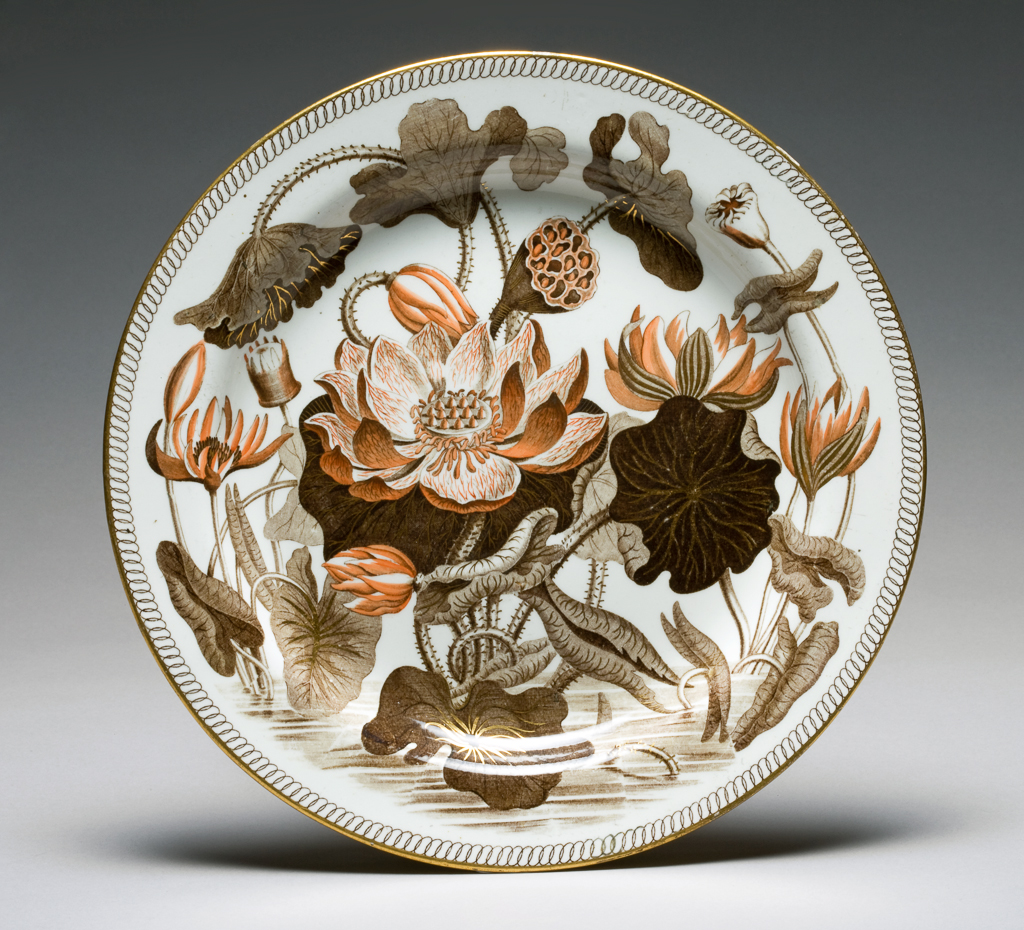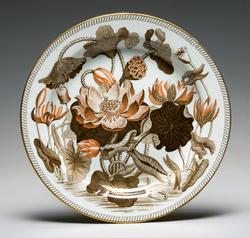Current Location: Gallery 33
Titles
Plate from the Darwin Service
Maker(s)
Factory:
Wedgwood & Byerley
Entities
Categories
Description
Earthenware plate printed and painted with 'Brown Water Lily' pattern
White earthenware printed underglaze in brown, painted overglaze in pale terracotta enamel and gilt. Circular with sloping rim, shallow well and flat centre. Decorated in the centre with 'Brown Water Lily' pattern, comprising on the left, Nymphaea stellata, on the right, Nymphaea lotus, and in the middle, Nelumbium speciosum (Nelumbo nucifera). On the rim, a border of overlapping circles and a gold band.
Notes
History note: Robert Waring Darwin, FRS (1766-1848) and his wife, Susannah (née Wedgwood, d. 1817), Shrewsbury; by descent in the Darwin family to George Pember Darwin (1928-2001), by whom lent to the Fitzwilliam in 1963.
Legal notes
Given by George Pember Darwin
Measurements and weight
Diameter: 24.8 cm
Height: 2.4 cm
Acquisition and important dates
Method of acquisition: Given
(1988-03-14)
by
Darwin, George Pember
Dating
19th Century, Early
George III
Circa
1807
CE
-
1808
CE
Note
The Brown Water Lily service was not designed specially for Susannah and Robert Darwin, but became known as the 'Darwin Service' because of theirs, which was ordered in 1807 and it had been received by 29 March 1808 as recorded in a letter from Susannah Darwin to her brother Josiah II (L.2.2.35). It had 150 pieces of which 129 are known, including 57 10 in plates (i.e. 9 7/8 in). There are plates in the British Museum (1887,0307,1.795), and the Victoria & Albert Museum (C.139-1963) and( Wedgwood Collection WE.4043-2014).
This pattern was no. 495 in the first Wedgwood Pattern Book, described as 'Brown printed Water Lily, shaded in red and cut up with gold, and gold outside edge'. It was the first printed botanical pattern to be produced at Etruria, following a decision to introduce underglaze printed ware in March 1805. The earliest invoice for engraving the plates was from Semei Bourne for a pickle saucer in 1806, and most of the designs for the prints for the dinner service were engraved by John Robinson in 1807. The water lilies were based on the following illustrations: The Botanists' Repository, vol. VI, October 1803, pl. 330, Nymphaea stellata; The Botanical Magazine, December 1804, pl. 797, Nymphaea lotus; The Botanists' Repository, vol. VI, September 1804, pl. 391, Nymphaea lotus; The Botanical Magazine, February 1806, pl. 903a & b, Nelumbium speciosum. This and a few other botanical patterns, such as Peony (see C.864-1984) appear to have been introduced at Etruria because of John Wedgwood's interested in botany, and after he withdrew from the firm in 1812, they were not continued.
School or Style
botanical
People, subjects and objects depicted
Components of the work
Decoration
composed of
enamel
( pale terracotta)
gold
Materials used in production
White earthenware
Lead-glaze
Techniques used in production
Moulding
: Earthenware printed underglaze in brown, painted overglaze in pale terracotta enamel and gilt.
Lead-glazing
Inscription or legends present
- Text: WEDGWOOD, 1 and slightly above to right, 1
- Location: On the base
- Method of creation: Impressed
- Type: Factory mark
References and bibliographic entries
Related exhibitions
Identification numbers
Accession number: C.3-1988
Primary reference Number: 11974
Stable URI
Audit data
Created: Saturday 6 August 2011
Updated: Monday 3 February 2025
Last processed: Thursday 14 August 2025
Associated departments & institutions
Owner or interested party:
The Fitzwilliam Museum
Associated department:
Applied Arts

 IIIF Manifest
IIIF Manifest






